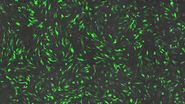Tracking Single Cells Using Deep Learning
A video presentation from Kristina Ulicna at the AI microscopy symposium

AI-based solutions continue to gain ground in the field of microscopy. From automated object classification to virtual staining, machine and deep learning technologies are powering scientific breakthroughs while helping microscopists streamline analysis.
Image: Separation of cells based on their tracking status: A colourised binary mask of a time-lapse microscopy field of view of medium confluency with individual cells highlighted as survivors if they can be tracked since the initial movie frame (cyan), incomers if they migrated into the field of view throughout the movie (yellow) or mistracks if an error occurred in the automated trajectory reconstruction (red).
Key Learnings
- Using multiple deep learning models and bTrack algorithms cell segmentation, cell state classification and single cell tracking can be fully automated
- Full single cell lineage tracing is possible and allows questions regarding heritable traits can be examined
- Wild-type MDCK cells have a large range of cell cycle durations and that this range may be maintained across lineages



